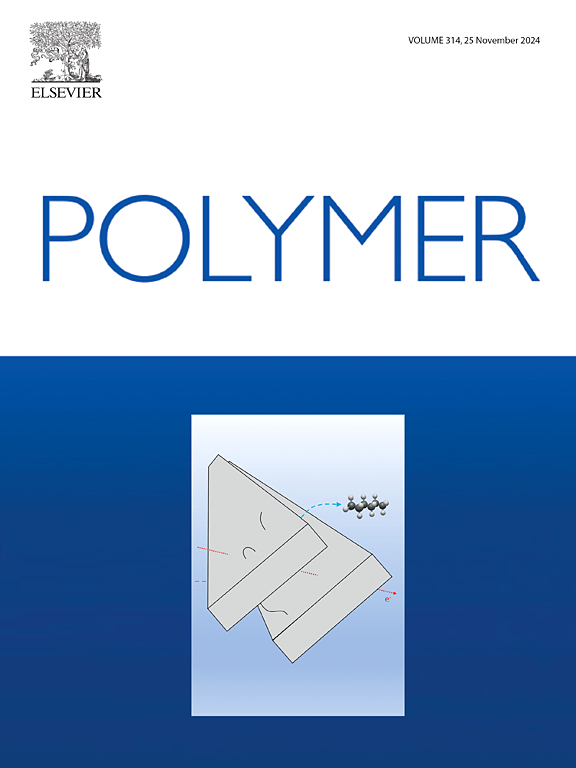A redox-active covalent organic framework with azo units for supercapacitor applications
IF 4.5
2区 化学
Q2 POLYMER SCIENCE
引用次数: 0
Abstract
Covalent organic frameworks (COF) exhibiting high specific surface area and pseudocapacitive activity are considered ideal candidates for energy storage electrode materials. Herein, two covalent organic frameworks (TFPAZO-COF and TFPDT-COF) with and without azo units in the backbone was synthesized and their potential application as a supercapacitor electrode material was explored. The specific surface area of the synthesized TFPAZO-COF was enhanced by using pyrrolidine in place of acetic acid as a catalyst, resulting in a value of 1010.9 m2 g−1. Moreover, TFPAZO-COF is enriched with abundant azo groups to achieve proton Grotthuss transfer and enhance the redox reaction of the electrode. The synergy between the double layer capacitance resulting from the adsorption of a large number of ions on the large specific surface area and the Faraday capacitance generated by the azo unit endows TFPAZO-COF excellent electrochemical properties. When evaluated in a three-electrode configuration with 1 M H2SO4 as the electrolyte, the specific capacity of TFPAZO-COF reaches 178 F/g at 0.5 A/g, significantly surpassing the performance of TFPDT-COF. Additionally, the asymmetric supercapacitor (ASC) device consisting of TFPAZO-COF and activated carbon (AC) achieved a maximum energy density and power density of 11.5 W h/kg and 450 W/kg, respectively. Furthermore, the TFPAZO-COF//AC ASC exhibits exceptional cycling stability, maintaining 86.1 % of its initial capacitance after 8000 cycles at 1 A/g.


一种用于超级电容器的具有氧化还原活性的偶氮共价有机骨架
共价有机框架(COF)具有高比表面积和假电容活性,被认为是储能电极材料的理想候选材料。本文合成了两种共价有机骨架(TFPAZO-COF和TFPDT-COF),并探讨了它们作为超级电容器电极材料的潜在应用前景。以吡咯烷代替乙酸,提高了TFPAZO-COF的比表面积,比表面积为1010.9 m2 g-1。此外,TFPAZO-COF富集了丰富的偶氮基团,实现了质子Grotthuss转移,增强了电极的氧化还原反应。由于在大比表面积上吸附大量离子产生的双层电容与偶氮单元产生的法拉第电容之间的协同作用,使TFPAZO-COF具有优异的电化学性能。在以1 M H2SO4为电解液的三电极条件下,TFPAZO-COF在0.5 a /g下的比容量达到178 F/g,明显优于TFPDT-COF。此外,由TFPAZO-COF和活性炭(AC)组成的非对称超级电容器(ASC)器件的最大能量密度和功率密度分别达到11.5 W h/kg和450 W/kg。此外,TFPAZO-COF//AC ASC具有出色的循环稳定性,在1 A/g下循环8000次后保持86.1%的初始电容。
本文章由计算机程序翻译,如有差异,请以英文原文为准。
求助全文
约1分钟内获得全文
求助全文
来源期刊

Polymer
化学-高分子科学
CiteScore
7.90
自引率
8.70%
发文量
959
审稿时长
32 days
期刊介绍:
Polymer is an interdisciplinary journal dedicated to publishing innovative and significant advances in Polymer Physics, Chemistry and Technology. We welcome submissions on polymer hybrids, nanocomposites, characterisation and self-assembly. Polymer also publishes work on the technological application of polymers in energy and optoelectronics.
The main scope is covered but not limited to the following core areas:
Polymer Materials
Nanocomposites and hybrid nanomaterials
Polymer blends, films, fibres, networks and porous materials
Physical Characterization
Characterisation, modelling and simulation* of molecular and materials properties in bulk, solution, and thin films
Polymer Engineering
Advanced multiscale processing methods
Polymer Synthesis, Modification and Self-assembly
Including designer polymer architectures, mechanisms and kinetics, and supramolecular polymerization
Technological Applications
Polymers for energy generation and storage
Polymer membranes for separation technology
Polymers for opto- and microelectronics.
 求助内容:
求助内容: 应助结果提醒方式:
应助结果提醒方式:


